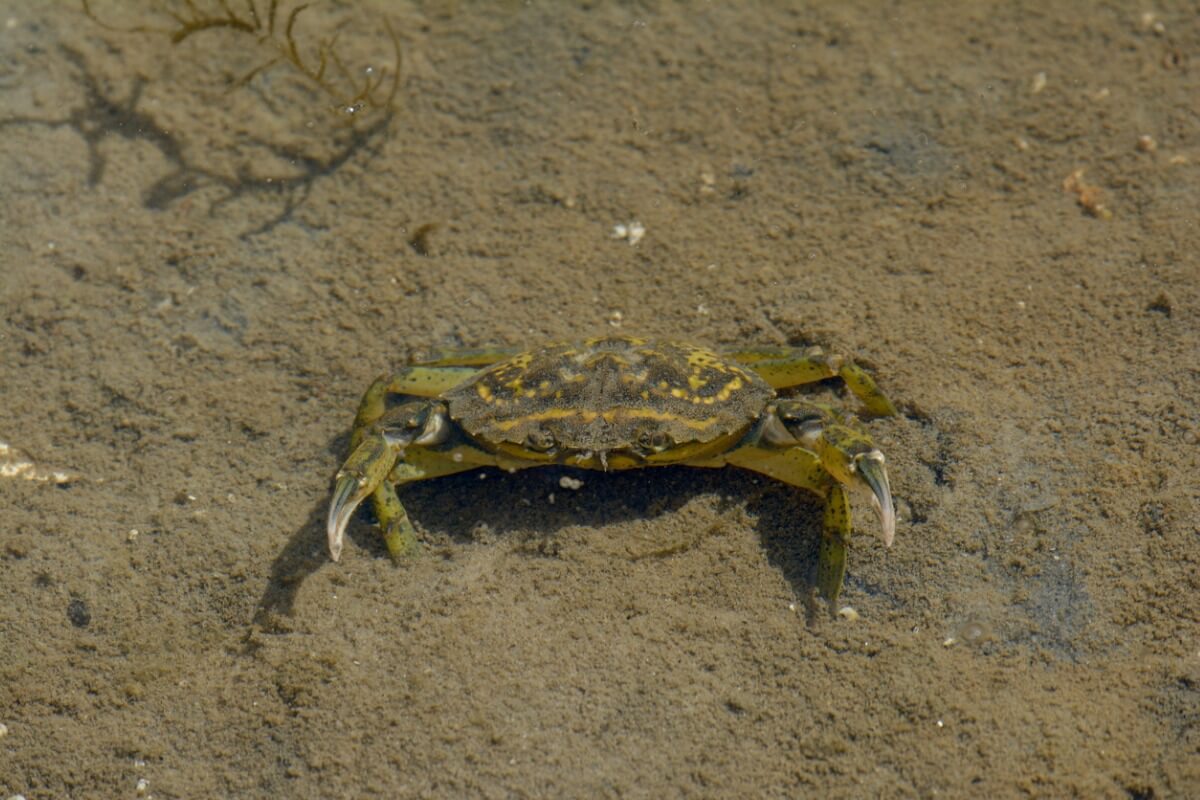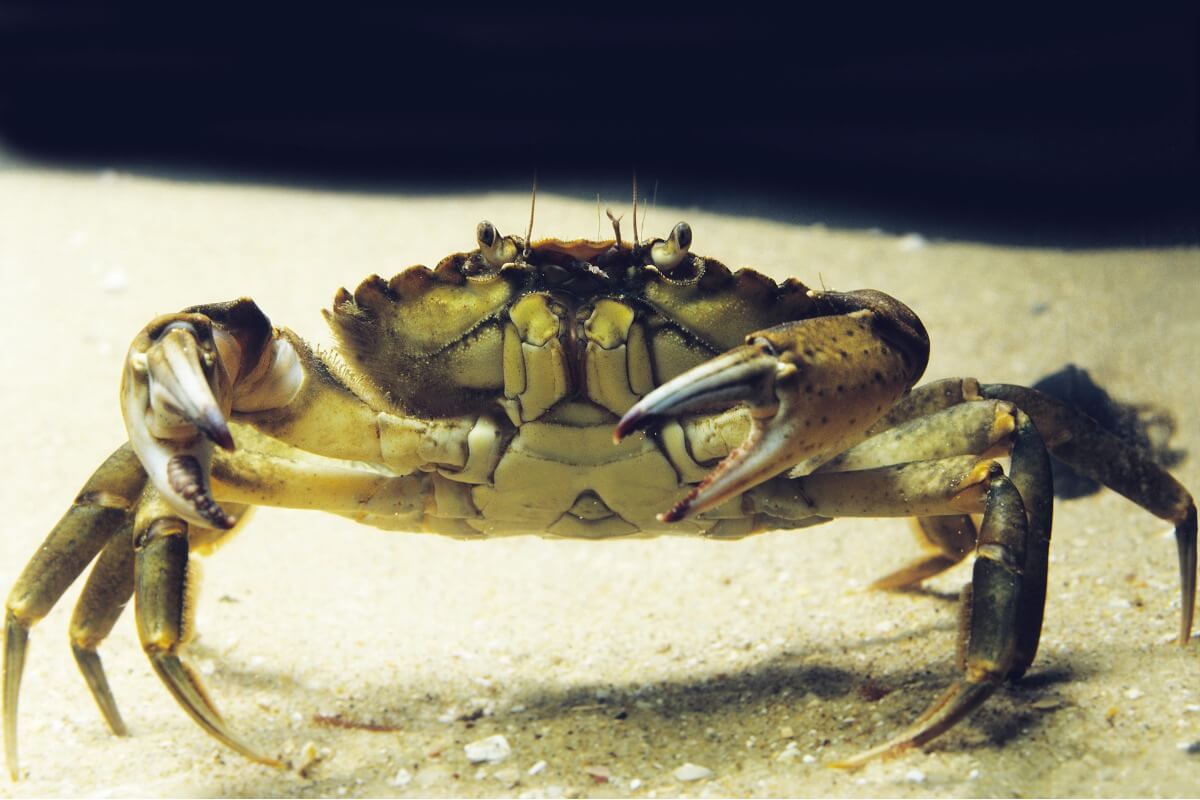Characteristics of the European Green Crab: An Invasive Species


Written and verified by the biologist Georgelin Espinoza Medina
The European green crab is a species that creates headaches worldwide. It’s native to the northeastern side of the Atlantic Ocean and also to the Baltic Sea. However, thanks to its capacity for tolerance, it has easily invaded other areas, and in the areas where it settles it causes ecological changes. Would you like to know the characteristics of the European green crab?
Invasive species represent a big problem in the ecosystems they occupy, as they cause imbalances and threaten the existence of native beings. One of the most harmful and unwanted is the European green crab or Carcinus maenas, and it’s important to know how to identify it. Here we’ll tell you all about it.
What’s the European green crab look like?
Like other crabs, C. maenas has a hardened shell, of around 9 centimeters (just under 4 inches). The male is larger than the female and its color varies between green (hence the common name), orange, and even a red color. Both sexes have a yellow spot on the abdomen.
Among the most striking characteristics of the European green crab is that it can vary its coloration with each molting cycle. In this way it adapts to the environment where it lives.
The most appropriate way to differentiate this crustacean from other crabs is the number of spines on the front edge of the carapace (on the outside of each eye). There are 5 of them, which is unique to this species. It has 5 pairs of locomotor appendages, the first one is modified in the form of pincers, and the last is a little flattened.
Habitat and distribution
This invertebrate is also known as the shore crab, as its habitat is beaches, marshes, and rocky coasts. It’s also found in areas with sandy or muddy bottoms, which it uses to hide. Either that or it hides in rocks, crevices, and vegetation.
As we’ve mentioned, this crab is naturally located in the coastal areas of Europe and North Africa, in the northeastern part of the Atlantic Ocean and in the Baltic Sea. However, it has been introduced to other parts of the world (namely North America, South America, Australia, South Africa, and Japan).

What does C. maenas feed on?
Among the most worrying characteristics of the European green crab is its diet, not only in terms of the type of food it eats, but also the amount it consumes. These animals are predators and have a voracious appetite, devouring large proportions of food.
Their prey is varied and their selection depends on many factors (size, location, and season of the year). Their diet includes crustaceans, worms, insects, bivalves, snails, urchins, jellyfish, foraminifera and fish, among others. They also consume algae, marsh vegetation, carrion and are even cannibalistic, as they can eat individuals of their own species.
As they grow, green crabs become more carnivorous than omnivorous. When they’re larger they have a high preference for bivalve mollusks, which they search for in the substrate by digging up to 15 centimeters (6 inches) deep.
Reproductive characteristics of the European green crab
The European green crab reproduces by laying eggs, which means that it’s oviparous. The process occurs in the summer stage, when it is the female’s turn to molt. She prepares herself by emitting pheromones to attract the male. He comes to her bidding, grabs her, and carries her for several days (from 2 up to 16).
This behavior continues until the female molts, and it’s then that copulation takes place. After that, the male continues to accompany her for about 2 more days.
Fecundity is high (up to 185,000 eggs per clutch) and increases with size, so larger females can lay more eggs than smaller ones. The eggs are laid in the sand and then form a sac that they take care of and carry around attached to their legs for a few months.
After the egg hatches, a planktonic larva emerges and goes through some changes or stages before becoming an adult. In total there are six of them (one protozoan, 4 zoea, and one megalopa). The duration of development is variable and depends on environmental conditions. It’s estimated at 62 days at 12° C (54° F) however, it can be reduced to 32 if temperatures rise to 18° C (65° F).
Other characteristics of the European green crab
Let’s look at other important aspects of the biological makeup of the European green crab. We highlight the following:
- Euryhaline: This crab tolerates varying concentrations of salts, which is designated by the term euryhaline. The range can go from 4 to 54%. However, during the larval stages, the value is reduced to 17 %.
- Eurythermal: The temperature range supported by this invertebrate is also wide. It survives from 0 to 33 °C. Similarly, in larvae, the tolerance is more limited and the optimal range is between 10 and 18 °C. The minimum value required for molting to occur in the species is 10 °C.
- This crab is adapted to low oxygen conditions.
The European green crab as an invader
These crabs have persisted and colonized other environments with ease thanks to the aforementioned characteristics. They have reached distant places intentionally (or not) by means of boats (attached to hulls, in ballast water, and packing materials) or by the action of recreational fishermen, as larvae are often used as bait in sport fishing.
There’s also a natural dispersal of its immature stages by currents and tides.
The green crab produces changes in the ecosystems it invades. Its voracious appetite, capable of destroying abundant bivalves (among other foods), causes the decline of the species that form part of its diet and encourages competition between native organisms.
This species feeds on important specimens for the fishing and aquaculture industry, so that economic losses are added to its negative effects.
Control and eradication of this crab is difficult. Methods such as fishing and poisoned bait have been used to control their populations, but the results have been ineffective. For this reason, in some regions, there are strict legal regulations that help to reduce the dispersion of this specimen.
A good alternative is biological control by predators or competitors. However, more research is needed in this field.

The characteristics of the European green crab make it a fearsome colonizer. Its enormous appetite, competition, high reproductive rate, and a great capacity to adapt to different temperatures and salinity are its most outstanding attributes. Learning to identify it and to understand its makeup is essential in order to devise successful control and eradication methods.
All cited sources were thoroughly reviewed by our team to ensure their quality, reliability, currency, and validity. The bibliography of this article was considered reliable and of academic or scientific accuracy.
- Baeta, A., Cabral, H., Marques, J., & Pardal, M. (2006). Feeding ecology of the green crab, Carcinus maenas (L., 1758) in a temperate estuary, Portugal. Crustaceana, 79(10), 1181-1193.
- Dawirs, R. (1985). Temperature and larval development of Carcinus maenas (Decapoda) in the laboratory, predictions of larval dynamics in the sea. Marine Ecology Progress Series, 24, 297–302.
- Torres, P., & González-Pizani, X. (2016). Primer registro del cangrejo verde, Carcinus maenas (Linnaeus, 1758), en Golfo Nuevo, Argentina: un nuevo límite norte de distribución en costas patagónicas. Eucología Austral, 26, 134-137.
- Young, A., & Elliott, J. (2020). Life History and Population Dynamics of Green Crabs (Carcinus maenas). Fishes, 5(1), 4.
This text is provided for informational purposes only and does not replace consultation with a professional. If in doubt, consult your specialist.